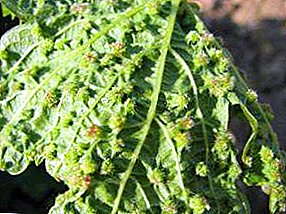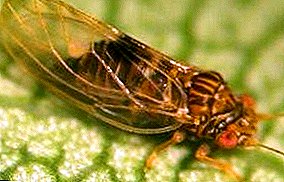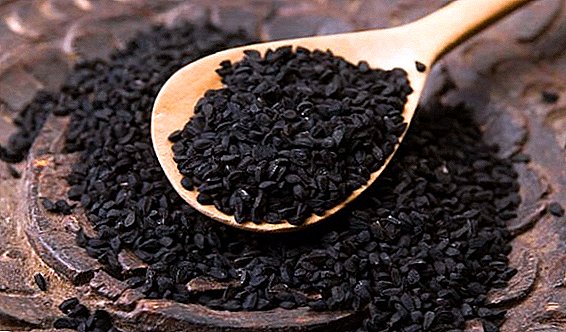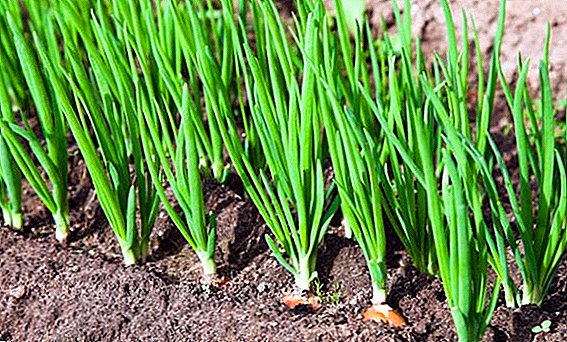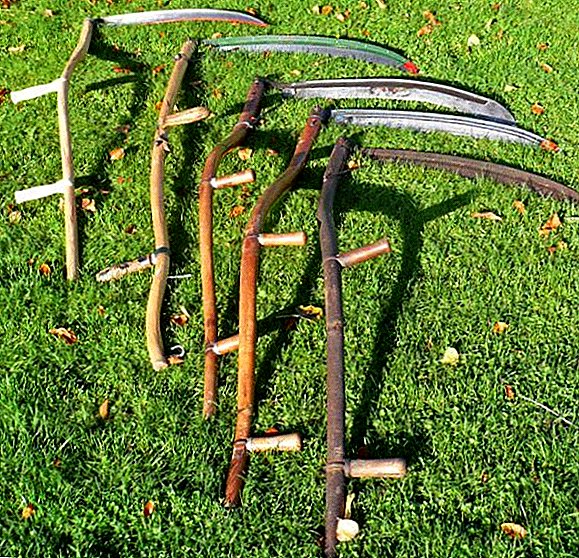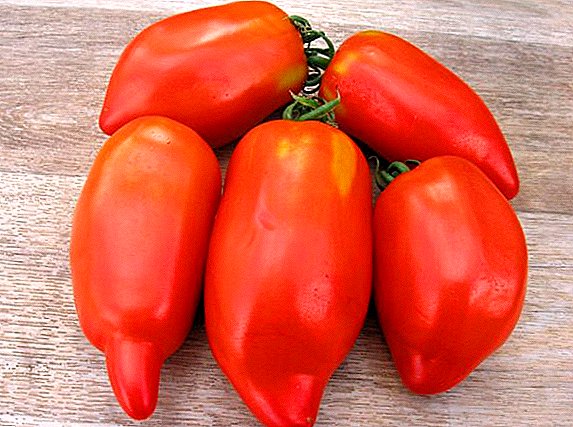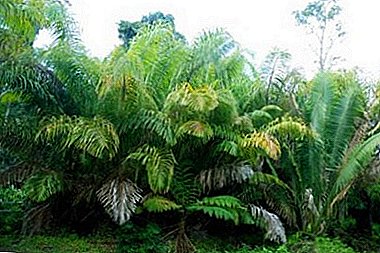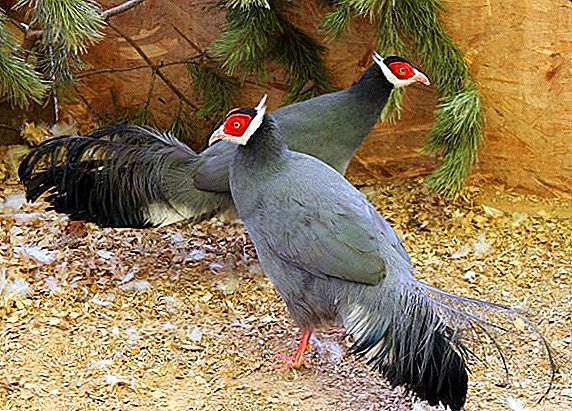 Eared pheasants are considered to be the largest representatives of their kind, and among other fellows stand out for their bright non-standard appearance. Their decorativeness is not only in the colorful plumage, but also in the structure of the body. What are the features of this bird, what it represents in the care and maintenance - learn further from the article.
Eared pheasants are considered to be the largest representatives of their kind, and among other fellows stand out for their bright non-standard appearance. Their decorativeness is not only in the colorful plumage, but also in the structure of the body. What are the features of this bird, what it represents in the care and maintenance - learn further from the article.
General description of eared pheasants
What these exotics look like is known only to Chinese residents and tourists. In the zoological fund of the planet there are very few of them, therefore birds are considered rare. In addition, according to scientists, there are no intersections of the ranges of individual species.
You will probably be interested in reading about how to catch a pheasant with your own hands.
Eared pheasants are noticeable from a distance in many ways. They are characterized by:
- large and elongated torso;
- short but strong red legs with long spurs;
- lush brush tail, consisting of 20-24 long and soft feathers;
- monochromatic color of plumage, which depends on the type of bird;
- powerful oblong beak;
- medium sized wings pressed tightly to the body;
- framing eyes with red leathery areas;
- black short feathers on a small head;
- big eyes;
- bright ear plumage specific form, which begins under the beard and stretches beyond the head.
 Investigating these birds, botanists could not distinguish the female from the rooster. And all because they lack sexual dimorphism. One can notice the difference between them only by weight parameters.
Investigating these birds, botanists could not distinguish the female from the rooster. And all because they lack sexual dimorphism. One can notice the difference between them only by weight parameters.Pheasant Species
In nature, there are only 4 species of eared pheasants. Between themselves, they differ in features and color of feathering, tail structure, weight and length. Let's take a closer look at these amazing representatives of the fauna.
Did you know? Buddhists assign eared white pheasants to sacred birds, and therefore took them under their protection.
White eared
The decisive sign of this species is the snow-white or bluish-white plumage. The bird has a black tint present only on the head, where there are velvety brush-like feathers, on the wings and tail. The interweaving of classic black and white tones harmoniously joined in a gray outline.  The head of the pheasant does not have long, ear-shaped feather processes. The large red leathery area that frames the yellow-orange eyes is separated by thick, slightly elongated feathers.
The head of the pheasant does not have long, ear-shaped feather processes. The large red leathery area that frames the yellow-orange eyes is separated by thick, slightly elongated feathers.
The beak of birds is light. Wing length - 33 cm. The tail is small and, in comparison with other species, less fluffy. It consists of only 20 upright-growing feathers, up to 58 cm long. The female weighs 1.4-2.0 kg, and the male - within 2.3-2.7 kg with the corresponding length of the body 86 and 96 cm.
Did you know? During winter snowfalls, white eared pheasants move, relying on outspread wide wings and a lowered tail. The trail left after the feathery is often confusing to enemy-minded crows.
The distribution range of the species is in the western regions of China, as well as Tibet and northeast India. In the wild, you can see such animals in rare mountain forests of mixed type. Pheasants also prefer oak-pine plantings. The bird wintering in the zone of cultural landscape, and in the summer does not cross the snow line in the mountains.  At present, the geography of distribution of this species is not yet fully understood. According to zoologists, for the location of white pheasants, the determining factors are the presence of water and food, as well as the absence of predators.
At present, the geography of distribution of this species is not yet fully understood. According to zoologists, for the location of white pheasants, the determining factors are the presence of water and food, as well as the absence of predators.
Poultry farmers should learn all the features of breeding pheasants at home.
In the wild, exotic animals live in flocks, which in winter can number up to 250 individuals. They feed on the roots of mountain vegetation, are characterized by a friendly disposition. They do not like to fly and hide from the hunters on the run, although the nature in them has the ability to climb several hundred meters.
At home, exotic birds demonstrate extreme endurance and activity. They are not afraid of cold and snow, but do not tolerate intense heat and direct sunlight, and, therefore, require protection in the heat. For comfortable keeping in captivity such living creatures will need a spacious, dry and clean enclosure. 
Blue (sky blue)
The species stands out among its fellows with a rich blue or grayish-ash tinge of a feather. The bird has a velvety black “cap” on its head, gray eyes, white elongated ear feathers that cover the chin and throat part.
From under them on a neck the dark border acts. The same color appears on the lower part of the tail and is characterized by a harmonious smooth transition to the base tone.
Important! In cramped conditions, pheasants for unknown reasons begin to pluck feathers on themselves and peck their feet.The beak of representatives of this species is dark brown. The wing is 30 cm long. There are 24 feathers in the tail, the length of which varies from 49 to 56 cm. Bright blue-green blurred points are clearly visible on the tips of the longest ones. Females weigh 1.5-1.7 kg, and males weigh 1.7-2.1 kg with a corresponding body length of 92 and 96 cm.
 In the wild, blue pheasants are found in the central and western regions of China, as well as in eastern Tibet. They are preferred for juniper mountain thickets, mixed forests (mainly birch and oak) and stone slopes. According to scientists, blue pheasants can choose for themselves the terrain without reference to water bodies.
In the wild, blue pheasants are found in the central and western regions of China, as well as in eastern Tibet. They are preferred for juniper mountain thickets, mixed forests (mainly birch and oak) and stone slopes. According to scientists, blue pheasants can choose for themselves the terrain without reference to water bodies.In the summer you can see them at the level of the upper outlines of pine forests, and in winter the eared birds descend below. They tolerate cold and snow well, but react painfully to heat and damp.
Did you know? Meat of brown eared pheasants is very much appreciated in cooking, as a result of which the species was on the verge of extinction.
In the natural environment, they lead a pack life, collecting up to 60 individuals. And with the onset of spring, when the nesting season comes, they form pairs. Sexual maturity is reached in the second year of life. During egg laying, no more than 12 eggs are harvested.
Video: blue eared pheasant in DonZoo kennel
Brown
One can recognize a brown pheasant among other brethren through the brown plumage of the main body and wings. His neck, as well as the tip of the tail, are characterized by a clear bluish-black border, the back is distinguished by a cream shade that smoothly flows over the tail feathers and merges with the brown tones.
Important! For homemade eared pheasants, peanuts can be offered as a delicacy. But to choose for such purposes you need only quality products. Do not forget that peanut beans are often the source of a carcinogen, aflatoxin, which destroys the liver of birds and animals. Unfortunately, roasting is not able to completely destroy the fungal toxin. Therefore, immediately reject the fruits with dark points of unknown origin.
On the head of the bird there is a traditional black velvet "cap", and its ear white feathers protrude beyond the top of the crown. Eyes are orange-yellow. The beak is distinguished by a yellowish-brown base and a red ending. Wing length - 32 cm. The tail consists of 22 magnificent feathers, up to 54 cm long. Females weigh 2.5 kg, and males - 2.7 kg with a corresponding body length of 96 and 100 cm.  Under natural conditions, birds prefer the northeastern zones of China with moderate climatic conditions. They do not tolerate heat and withstand cold well. Very afraid of rain and excessive moisture. For dwelling pheasants choose mountain mixed forests, shrub undergrowths and dense grassy meadows.
Under natural conditions, birds prefer the northeastern zones of China with moderate climatic conditions. They do not tolerate heat and withstand cold well. Very afraid of rain and excessive moisture. For dwelling pheasants choose mountain mixed forests, shrub undergrowths and dense grassy meadows.
The brown pheasant feeds on vegetable feed, which makes up to 70% of its daily diet. In the wild, when a bird searches for food, it can turn huge stones with its beak in order to get the desired root. This feature should be taken into account by breeders and planting open-air cages with edible non-toxic vegetation.
For full growth pheasants need a proper, balanced diet. Read about feeding pheasants at home.
Brown pheasant leads pack lives. In captivity, non-conflict, well tamed and amenable to training. In the mating season, roosters are more aggressive. Layers lay about 8 eggs with olive shells.
Video: brown eared pheasant in DonZoo kennel
Tibetan
This species of exotic feathered is not much different from the white species. The birds also have velvety dark plumage on the head, short ear feathers of white color, yellow-brown eyes and a light feather of the body. The wings are characterized by a brownish tint.
The main distinctive feature of Tibetan pheasants is the narrow tail of a dark color, which consists of 20 feathers up to 35-40 cm long. The hens weigh about 1.9 kg and the roosters do not exceed 2.4 kg with a corresponding body length of 88 and 92 cm.
We advise you to get acquainted with the best breeds of pheasants, as well as consider all the subtleties of the content of the golden pheasant at home.
Birds live in the south-east of Tibet, as well as in Indochina. For life choose mountain forests with dense thickets of rhododendron. Prefer to nest at an altitude of 2800-4700 meters above sea level. They live in packs, which in spring break up into pairs. Between April and June, females begin egg-laying.  Birds react painlessly to severe winters, can withstand frost and snow. Along with this, they do not tolerate high temperatures and can not stand the rain.
Birds react painlessly to severe winters, can withstand frost and snow. Along with this, they do not tolerate high temperatures and can not stand the rain.
Important! When arranging the enclosure, take care that there is a thick sand litter in it, because eared pheasants are excellent excavators. Otherwise, the wards will destroy all the fenced territory for them.
Is it possible to keep in captivity
Eared pheasants can live in captivity up to 20 years, subject to the necessary rules of detention. To do this, the breeder must take care in advance of a cozy bird housing and a spacious aviary. These exotics do not need excessive warming and lighting of the house. For them, the main thing is that the house was dry and clean.
Birds can not stand the excess heat and moisture, but can comfortably walk in the snow. Therefore, in captivity for them it is necessary to exclude any sources of dampness. To this end, experienced pheasant breeders are advised to build a spacious enclosure with an area of at least 19 square meters. m. It is best to install it to find well-drained areas where rain and melt water will not gather.  The aviary must be covered with a net to prevent the escape of exotic animals. In addition, inside it is necessary to provide a wooden house for nesting and overnight stays, as well as a small hinged structure for shelter from the scorching sun and rain.
The aviary must be covered with a net to prevent the escape of exotic animals. In addition, inside it is necessary to provide a wooden house for nesting and overnight stays, as well as a small hinged structure for shelter from the scorching sun and rain.
Among the important attributes of the house are traditionally perches, nests, feeders and drinkers. Place these items, guided by practicality and convenience for the "tenants".
Today, among poultry, exotic are becoming increasingly popular: quails, pheasants, ostriches and guinea fowls.
The diet of unique wards in captivity should not be radically different from the natural. Experts advise to make a daily diet of granular animal feed, greenery and small invertebrates. Ideally, poultry farmers should keep to the ratio of 70:20:10. Pheasants will willingly eat grass, leaves of fruit trees, as well as berries and fruits.  Eared pheasants are beautiful exotic birds. Having got them in your household, you will receive not only tasty meat, but also aesthetic pleasure from the contemplation of these colorful exotic elements.
Eared pheasants are beautiful exotic birds. Having got them in your household, you will receive not only tasty meat, but also aesthetic pleasure from the contemplation of these colorful exotic elements.


